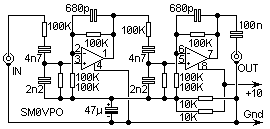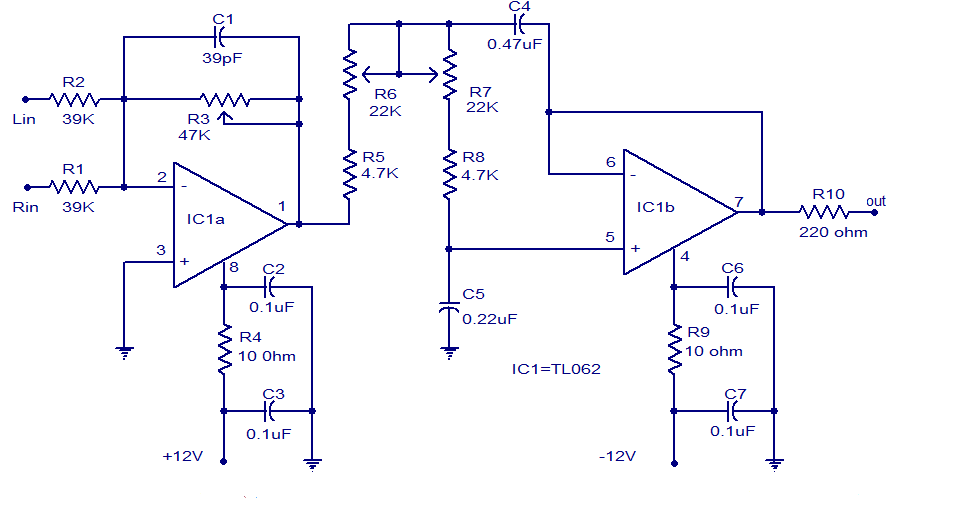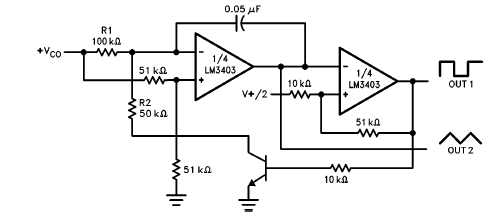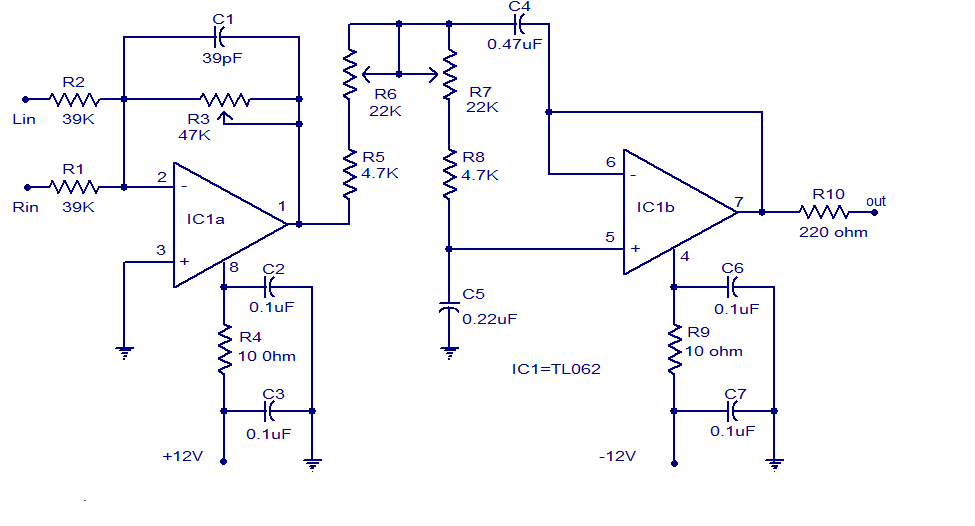
Fast-Response (Settling) Low-Pass Filter
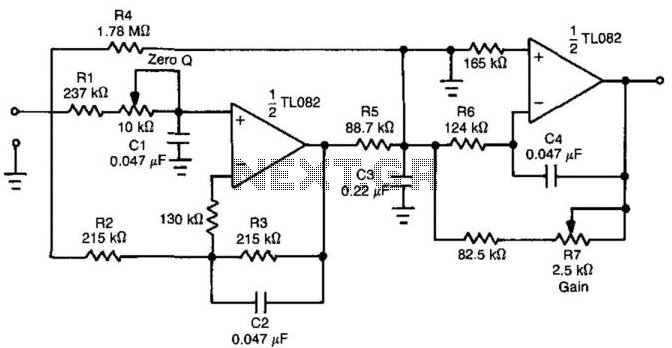
By introducing an additional transmission zero to the stopband of a low-pass filter, a sharper roll-off characteristic can be achieved. The filter design example illustrated in Figure 30-1(a) demonstrates that the time-domain performance of the low-pass section can also be enhanced. Figure 30-1(b) presents the attenuation characteristic of the proposed circuit. The position of the transmission zero is determined by the passive components surrounding the first operational amplifier, which was selected to achieve a 60 dB rejection at 60 Hz. A suitable fourth-order Bessel filter exhibits the frequency response indicated by the dashed line. Its response to a step input is characterized by a settling time to 0.1% of 1.8 times the cutoff frequency (Fc), equating to 180 ms. Figures 30-1(c) and 30-1(d) depict the step response for the filter shown in Figure 30-1(a) on both normal and expanded voltage scales. The settling time to 0.1% is below 100 ms, with overshoot and ringing remaining below 0.03%. This notable improvement in speed and accuracy can be critical, especially for low-frequency applications. An averaging filter for low-frequency linear or true RMS AC-to-DC converters serves as an example. Some anti-aliasing applications may also be relevant. For optimal performance, it is recommended that the resistance ratios R4/R5 = 20, R1 + R2 = 1kΩ, and capacitance ratios C3 + C2 = C3 + C4 = 4.7nF be maintained for any chosen cutoff frequency (Fc).
The described low-pass filter design incorporates an innovative approach to enhance performance by strategically positioning a transmission zero within the stopband. This design is particularly valuable in applications requiring precise signal processing, such as audio and instrumentation systems. The operational amplifier configuration is crucial, as the choice of passive components directly influences the filter's frequency response and transient behavior.
The fourth-order Bessel filter is specifically chosen for its maximally flat group delay characteristics, making it suitable for applications where phase distortion must be minimized. The design not only achieves a sharp roll-off but also ensures that the settling time remains within acceptable limits, enhancing the filter's overall performance in real-world scenarios.
The filter's attenuation characteristic, as depicted in Figure 30-1(b), provides a visual representation of the filter's effectiveness in rejecting unwanted frequencies. The design's ability to maintain a rejection level of 60 dB at 60 Hz is particularly noteworthy, as it demonstrates the filter's capability in low-frequency environments.
The settling time analysis reveals that the filter achieves a response time of less than 100 ms to reach 0.1% of the final value, which is a significant improvement over traditional designs. The minimal overshoot and ringing further confirm the filter's stability and reliability, making it suitable for sensitive applications.
In terms of practical implementation, attention must be given to the specified resistance and capacitance ratios to ensure that the filter performs optimally across various cutoff frequencies. This attention to detail in component selection is essential for achieving the desired performance metrics in low-frequency applications, including averaging filters in AC-to-DC conversion and anti-aliasing scenarios. By adhering to these design principles, the resulting low-pass filter can effectively meet the stringent requirements of modern electronic systems. By introducing an extra transmission zero to the stopband of a low-pass filter, a sharp roll-off c haracteristic can be obtained. The filter design example of Fig. 30-l(a) shows that the time-domain performance of the low-pass section can also be improved. Figure 30-1 (b) shows the attenuation characteristic of the proposed circuit. Position of the transmission zero is determined by the passive components around the first op amp. It was chosen to obtain 60 dB of rejection at 60 Hz. A suitable fourth-order Bessel filter has the frequency response, as shown by the dashed line. Its response to a step input is characterized by settling time to 0.1 % of 1.8 -f Fc = 180 ms. Figure 30-l(c) and 30-l(d) represent the step response for the filter of Fig. 30-l(a) in both normal and expanded voltage scales. As you can see, settling time to 0.1% is below 100 ms; overshoot and ringing, stay below 0.03%. This quite significant speed and accuracy improvement can be a major factor, particularly for low-frequency applications. Averaging filter for low-frequency linear or true rms ac-to-dc converters is an example. Some anti-aliasing applications can also be considered. For best results, resistance ratios R4-rR5 = 20, Re + R$=1A, and capacitance ratios C3 + C2 = C3 -f C4 = 4.7 should be kept up for any selected Fc.
🔗 External reference
The described low-pass filter design incorporates an innovative approach to enhance performance by strategically positioning a transmission zero within the stopband. This design is particularly valuable in applications requiring precise signal processing, such as audio and instrumentation systems. The operational amplifier configuration is crucial, as the choice of passive components directly influences the filter's frequency response and transient behavior.
The fourth-order Bessel filter is specifically chosen for its maximally flat group delay characteristics, making it suitable for applications where phase distortion must be minimized. The design not only achieves a sharp roll-off but also ensures that the settling time remains within acceptable limits, enhancing the filter's overall performance in real-world scenarios.
The filter's attenuation characteristic, as depicted in Figure 30-1(b), provides a visual representation of the filter's effectiveness in rejecting unwanted frequencies. The design's ability to maintain a rejection level of 60 dB at 60 Hz is particularly noteworthy, as it demonstrates the filter's capability in low-frequency environments.
The settling time analysis reveals that the filter achieves a response time of less than 100 ms to reach 0.1% of the final value, which is a significant improvement over traditional designs. The minimal overshoot and ringing further confirm the filter's stability and reliability, making it suitable for sensitive applications.
In terms of practical implementation, attention must be given to the specified resistance and capacitance ratios to ensure that the filter performs optimally across various cutoff frequencies. This attention to detail in component selection is essential for achieving the desired performance metrics in low-frequency applications, including averaging filters in AC-to-DC conversion and anti-aliasing scenarios. By adhering to these design principles, the resulting low-pass filter can effectively meet the stringent requirements of modern electronic systems. By introducing an extra transmission zero to the stopband of a low-pass filter, a sharp roll-off c haracteristic can be obtained. The filter design example of Fig. 30-l(a) shows that the time-domain performance of the low-pass section can also be improved. Figure 30-1 (b) shows the attenuation characteristic of the proposed circuit. Position of the transmission zero is determined by the passive components around the first op amp. It was chosen to obtain 60 dB of rejection at 60 Hz. A suitable fourth-order Bessel filter has the frequency response, as shown by the dashed line. Its response to a step input is characterized by settling time to 0.1 % of 1.8 -f Fc = 180 ms. Figure 30-l(c) and 30-l(d) represent the step response for the filter of Fig. 30-l(a) in both normal and expanded voltage scales. As you can see, settling time to 0.1% is below 100 ms; overshoot and ringing, stay below 0.03%. This quite significant speed and accuracy improvement can be a major factor, particularly for low-frequency applications. Averaging filter for low-frequency linear or true rms ac-to-dc converters is an example. Some anti-aliasing applications can also be considered. For best results, resistance ratios R4-rR5 = 20, Re + R$=1A, and capacitance ratios C3 + C2 = C3 -f C4 = 4.7 should be kept up for any selected Fc.
🔗 External reference


